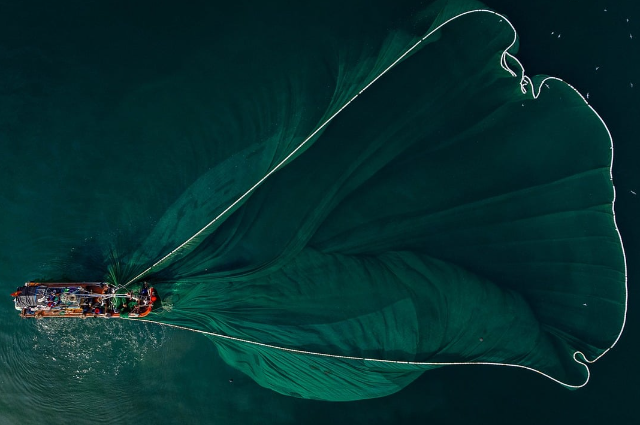
Image by Nghĩa Đặng from Pixabay
Abstract: Aquatic life's behaviour is influenced by tides, seasonal variations, and circadian rhythms, all of which are influenced by moon phases. Moon phases have a particular e ect on marine life, including creatures found in rivers, seas, and mangrove ecosystems, as well as fisheries. Shrimp biological cycles are indirectly impacted by moon phase phenomena. Because of the earth's rotation and the gravitational pull of the sun and moon, moon phases have an impact on natural phenomena like tides. Fishing has benefited from the application of this knowledge. Moon phases are known to influence the moulting cycles of crustacean farming.
Tide: The Definition
When the Moon and Sun exert their forces on the ocean, very long-period waves called tides are created. The sea surface rises and falls on a regular basis because of tides, which begin in the ocean and move toward the coastline.
Tides are brought on by the gravitational pull of the Moon and Sun. Sea levels rise and fall due to tides, which are also a result of the Earth and Moon orbiting each other and the combined gravitational pull of the Moon and, to a lesser degree, the Sun. A tide is the periodic rise and fall of ocean water. It results from the combination of:
- The gravitational pull that the Sun has on the Earth.
- The gravitational pull that the Moon has on the Earth.
- The Earth's rotation.
Effect of Tidal Waves
Because tides raise the sea level, a significant portion of the ocean is left vulnerable to erosion. It helps the tidal ports with shallow water, which makes it di icult for large ships to enter. A highly promising source of tidal energy, tidal currents are extensively exploited in many developed nations, including India to some degree. When the tide becomes excessively high and floods the surrounding coastal areas, it can be disastrous. Ecosystems like coral reefs and mangrove forests depend heavily on tides to grow and survive.
Stages of Tides form
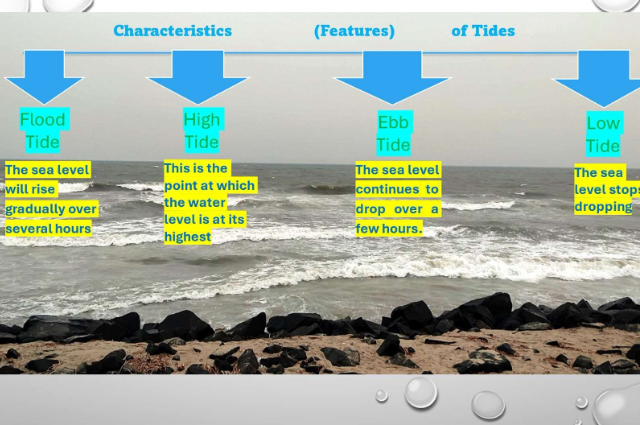
The four stages listed below indicate how the tides change.
- Flood Tide: The sea level will rise gradually over several hours.
- High Tide: This is the point at which the water level is at its highest.
- Ebb Tide: During this phase, the sea level continues to drop over a few hours.
- Low Tide: The sea level stops dropping.
Both the mass and separation from one another determine the gravitational force between these bodies. that the Sun is located much farther from Earth than the Moon. The gravitational pull of the Earth is therefore less than that of the moon. The moon, therefore, controls the tide's magnitude. Contrary to popular belief, not all bodies of water are a ected by the gravitational pull. Land and water bodies are subject to the gravitational pull. Since water has a stronger gravitational pull than the ground, the impact of gravity on water bodies is greater.
TYPES OF TIDES
Based on the Position of The Earth, Sun & Moon:
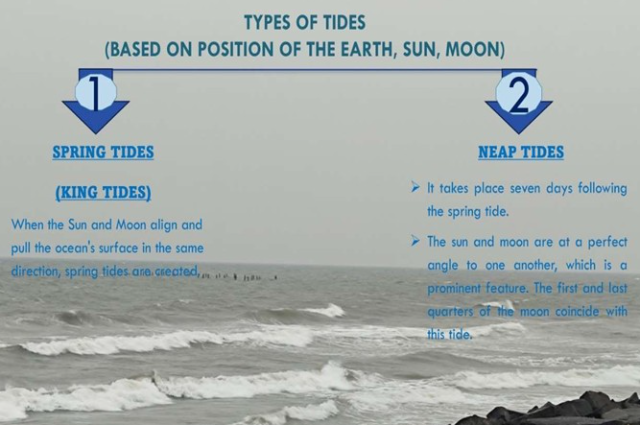
Spring Tides
- Spring tides are produced when the moon and sun line up and pull the ocean's surface in the same direction.
- This results in a fall in low tides and an increase in high tides, which are referred to as spring tides. When the sun and moon align and pull the ocean's surface in the same direction, spring tides are created.
- This causes the high tides to rise and the low tides to fall; this type of tide is known as a spring tide.
- Twice in a lunar month, it happens. It is also referred to as "King Tide."
Neap Tides
- It takes place 7 days following the spring tide.
- The Sun and Moon are at a perfect angle to one another, which is a prominent feature.
- The first and last quarters of the moon coincide with this tide. The resulting oceanic bulge and the gravitational pull of the sun cancel each other out.
- This includes the gravitational pull of the moon.
- Additionally, during neap tides, the low tides are relatively "higher" and the high tides are "lower" than during spring tides.
Based on Tides Frequency:
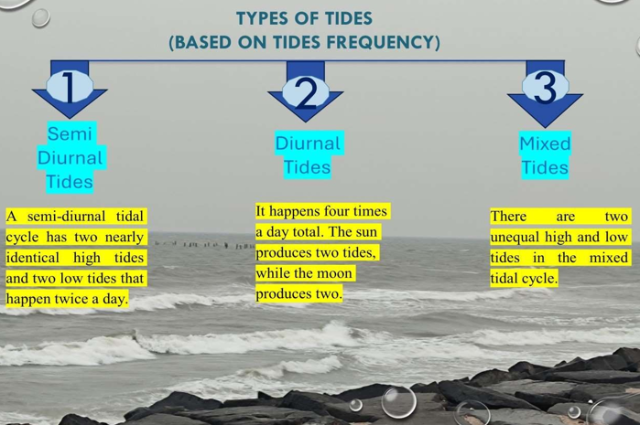
Semi-Diurnal Tides
- A semi-diurnal tidal cycle consists of two almost identical high tides and two twicedaily low tides.
- 12 hours and 25 minutes elapse between high and low tides.
- Most semi-diurnal tides occur in the Indian Ocean.
- It is common to observe semi-diurnal tides along several coasts, including the Bay of Bengal.
Diurnal Tides
- It happens four times a day total. The sun produces two tides, while the moon produces two.
- The sun and moon have a complimentary relationship, which results in a high spring tide.
- During a solar or lunar eclipse, the sun, moon, and earth align nearly exactly in a straight line, a phenomenon known as a syzygy, which happens when three or more celestial bodies in a gravitational system form a nearly straight line.
- Syzygies come in two varieties: opposition and conjunction. Mixed Tides
- There are two unequal high and low tides in the mixed tidal cycle.
- This tide cycle has both nocturnal and semi-diurnal oscillations.
Mechanism of Tides:
Understanding the gravitational pull of the Sun and Moon will help one to understand the mechanism underlying the tides. Because the Sun is farther away from Earth than the Moon is, these bodies are pulled apart by gravity depending on their mass and distance from one another. Because of this, the Earth is less affected by the sun's gravitational pull than the moon. Thus, the height of the tide is determined by the moon.
How do tides affect the moulting cycle?
Aquatic life's behaviour is influenced by tides, seasonal variations, and circadian rhythms, all of which are influenced by moon phases. Moon phases have a particular effect on marine life, including creatures found in rivers, seas, and mangrove ecosystems, as well as fisheries. Fish & Shrimp biological cycles are indirectly impacted by moon phase phenomena.
Shrimp go through a recurring process called moulting as part of their growth. Because the shrimp's exoskeleton does not develop along with its body, it must "change its skin." Shrimp that are under stress may also moult.
Moon phases have been linked to Shrimp (Both Monodon & Vannamei) moulting cycles. Almost 80% of shrimp reach the ecdysis stage (the exoskeleton-shedding process) during the new moon. Moulting of shrimp typically occurs at night, during high tides or during a full moon.
Moult, Post moult, Intermoult, and Pre moult are the four stages of a moulting cycle. The process of ecdysis is the moult phase. The period following ecdysis is referred to as post moult, during which the exoskeleton is still soft and takes up minerals. The exoskeleton is then made harder by mineralization.
The longest inactive phase of moulting cycles is called the inter-moult, or an ecdysis phase. Both muscle regeneration and energy storage for the subsequent ecdysis take place during this period. A phase known as pro ecdysis or pre moult is when somatic muscle atrophy takes place. To create a new exoskeleton in preparation for ecdysis, minerals from the exoskeleton are reabsorbed during pre-moult.
When moulting, shrimp require an adequate supply of minerals and nutrients. Magnesium and calcium are two of the most vital minerals, as they aid in the rapid regeneration of new exoskeleton.
Shrimp that are moulting will fast and use up their body's protein stores to form a new exoskeleton in a matter of hours. Because of how dangerous this process is, shrimp will be more susceptible to changes in the quality of the water, particularly when it comes to maintaining their internal osmotic pressure. Should this state persist, osmotic shock—a condition in which the shrimp's cells absorb too much water—may transpire.
The partial decomposition of the exoskeleton that happens during moulting easily stimulates another shrimp.
Shrimp that are not moulting or have just moulted have a greater appetite when exposed to fluids that contain amino acid compounds, enzymes, and other organic compounds. This could lead to cannibalism.
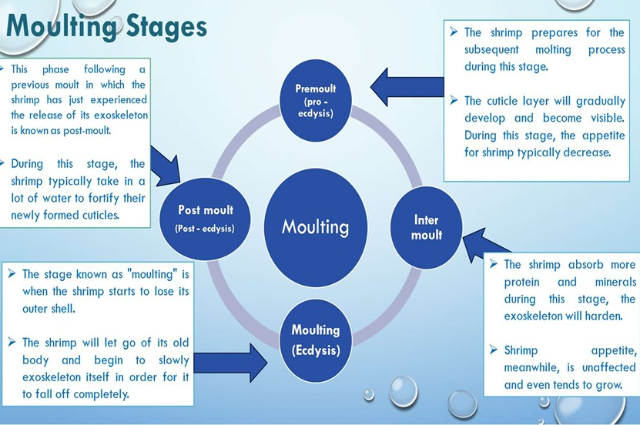
ECLIPSE
When one celestial body moves into the shadow of another, or when one body moves in front of the other, an eclipse is an astronomical event that takes place.
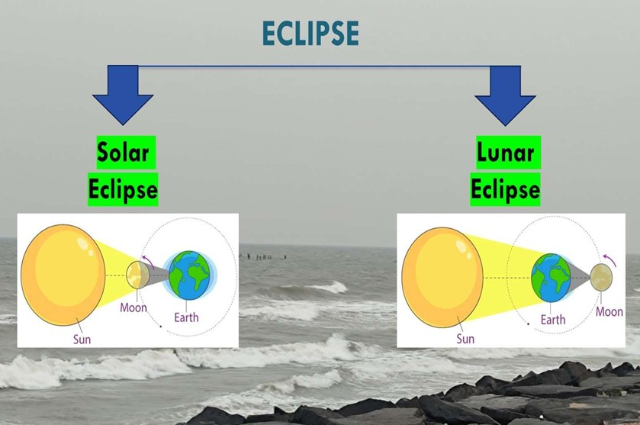
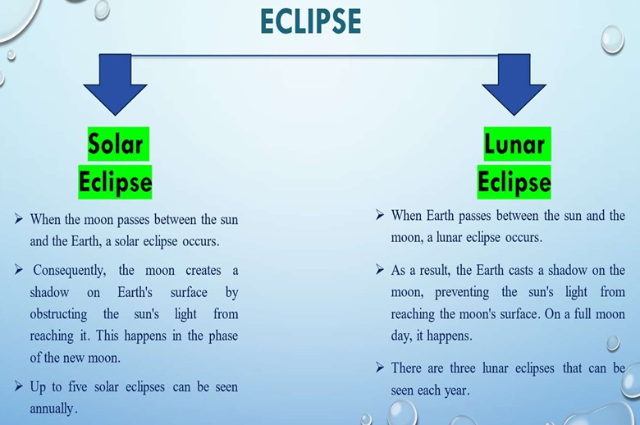
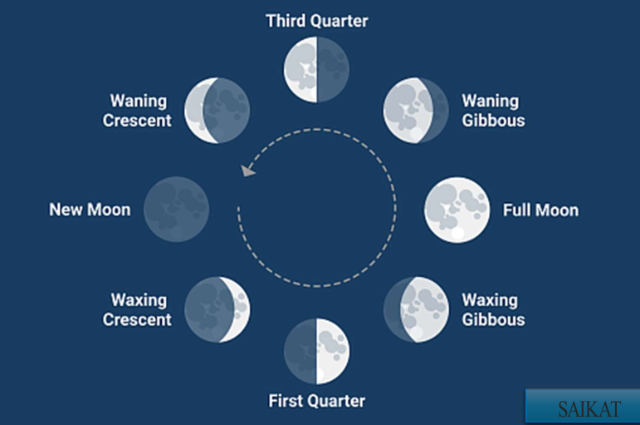
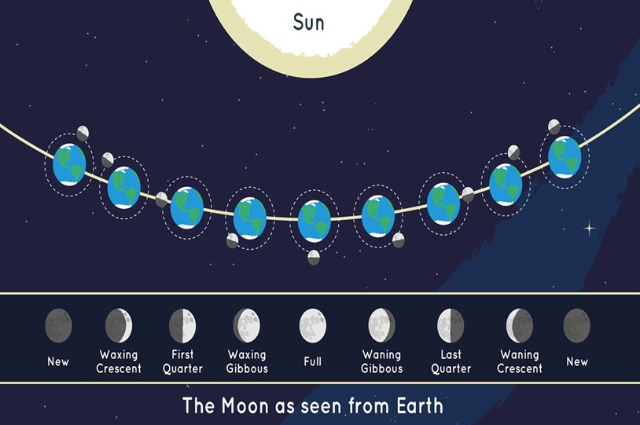
The Eight Phases of the MOON
| Phrases | Definition |
| Lunar rhythms | Lunar rhythms are biological rhythms with a periodicity of 29.53 days that are synchronized with the movement of the moon and tides. |
| Lunar phase | A lunar phase, also referred to as the Moon phase, is the apparent shape of the directly sunlit area of the Moon as viewed from Earth. The new moon, first quarter, full moon, and last quarter are the four main phases as they are commonly known. |
Waxing Crescent | Once a month, the moon goes through its second phase, which is known as a waxing crescent moon. |
| Waxing Gibbous | The moon is not yet full but is The fourth phase of the moon's |
| Waning Gibbous | The sixth phase of the moon's |
Waning Crescent | Every month, following the third quarter moon and preceding the new moon, the waning crescent represents the eight & last stage of the lunar cycle. |
| Lunar Eclipse | When Earth passes in front of the Sun and the Moon during a lunar eclipse, the Moon is shaded from sunlight. |
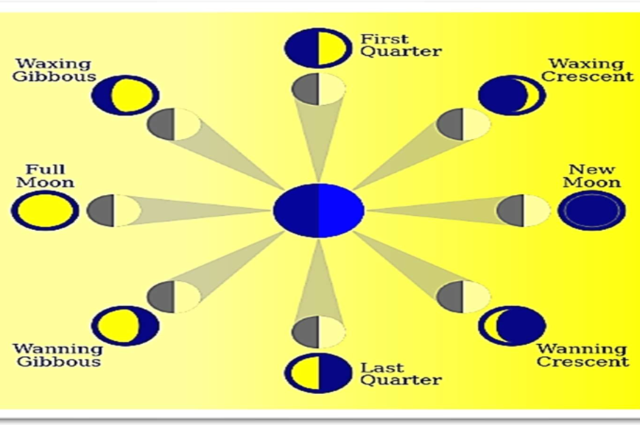
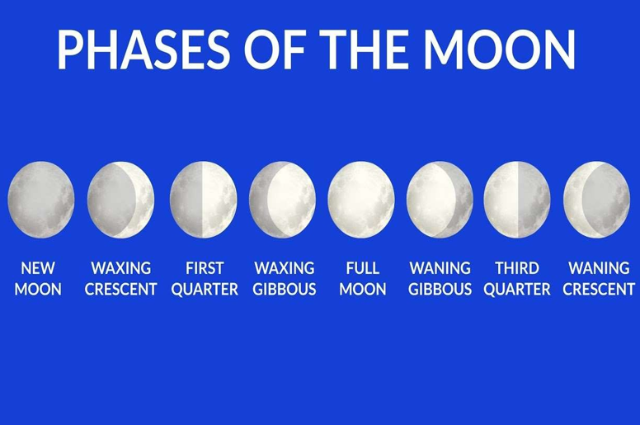
The Total Cycle repeats every 29.5 days in a month.
. . .
References:
- Edwards, A. A., Steacy, L. M., Siegelman, N., Rigobon, V. M., Kearns, D. M., Rueckl, J. G., & Compton, D. L. (2022).
- Journal of Psychology, 114(6), 1242– 1256;https://doi.org/10.1037/edu0000696 Online Magazine Article (Section 10.1) Thomson, J. (2022, September 8).
- Massive, strange white structures appear on Utah’s Great Salt Lake. Newsweek. https://www.newsweek.com Print Magazine Article (Section 10.1) Nicholl, K. (2020, May).
- Online Newspaper Article (Section 10.1) Roberts, S. (2020, April 9). Early string ties us to Neanderthals. The New York Times. https://www.nytimes.com/2020/04/09/science
- Print Newspaper Article (Section 10.1) Reynolds, G. (2019, April 9). The New York Times, D4.Blog Post (Section 10.1) Rutledge, P. (2019, March The upside of social media. The Media Psychology Blog;
- https://www.pamelarutledge.com Authored Book (Section 10.2) Kaufman, K. A., Glass, C. R., & Pineau, T. R. (2018).
- https://www.nasa.gov/ https://doi.org Edited Book Chapter (Section 10.3) Zeleke, W. A., Hughes, T. L., & Drozda, N. (2020). https://doi.org/10.1037/0000157-002 Online Dictionary Entry (Section 10.3)
- https://www.noaa.gov/ Internet addiction. In APA dictionary of psychology.
- https://dictionary.apa.org/internet-addiction Report by a Group Author (Section 10.4)
- https://tides4fishing.com/tides/types.
